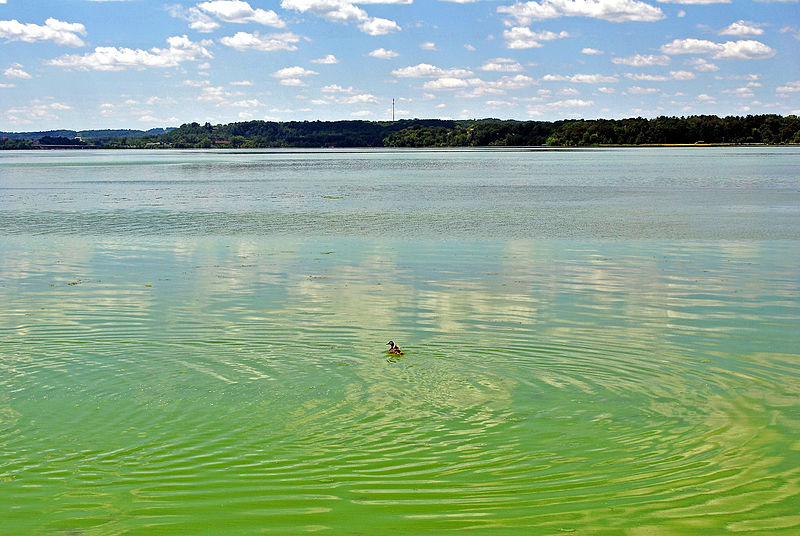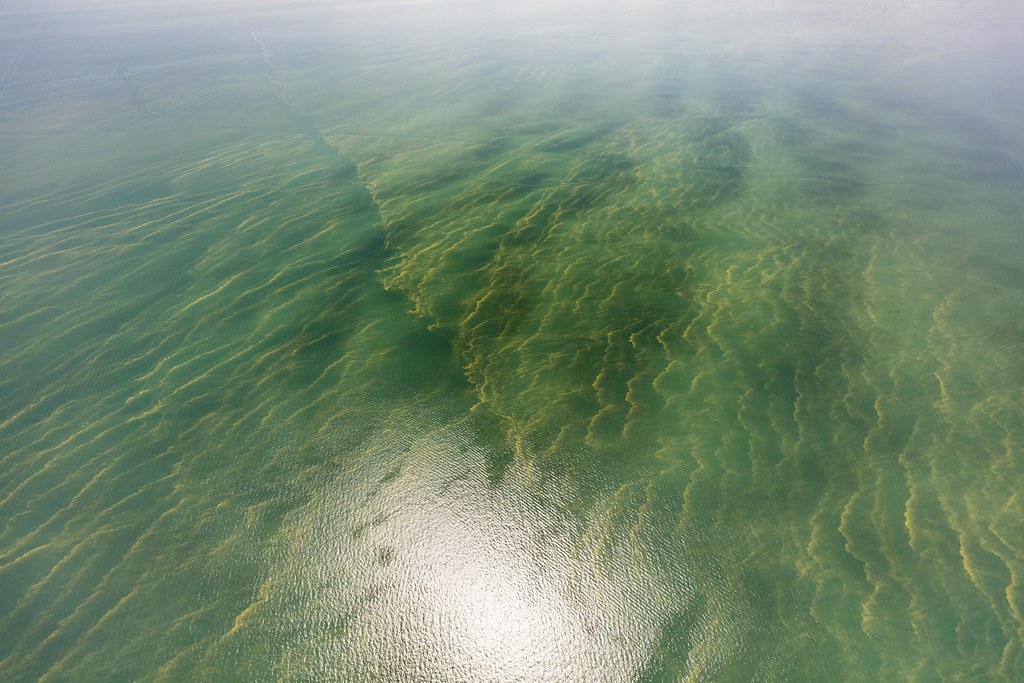Conservation and Biodiversity
How toxic algae blooms work
September 6, 2019
As algae blooms explode around the U.S., infecting shorelines with toxic, sludgy waters, an otherwise relaxing day at the beach can quickly turn into a hazardous mess.
Last week, the National Oceanic and Atmospheric Administration issued a harmful algae bloom bulletin about the western basin of Lake Erie, warning that toxic algae in Lake Erie may be “exceeding the recreational threshold.”
Cuyahoga County, which contains Cleveland, Ohio, and surrounding counties have issued similar advisories, in some cases closing beaches entirely. Besides ruining a day at the beach, though, these toxic waters can disrupt ecosystems, hurt people and, in the case of recent reports from New York City, even kill dogs.
Algae blooms aren’t small, isolated events: Lake Erie’s current algae bloom is roughly 620 square miles, large enough to cover all of Los Angeles. Meanwhile, algae blooms have been cited in the Gulf of Mexico, Gulf of Maine and Gulf of California and everywhere in between, including small lakes, ponds and rivers.
“The problem for everything is that, in most cases, it’s all connected,” says Wayne Wurtsbaugh, an ecologist and professor emeritus at Utah State University, in an interview with Earth Day Network.
The problem for everything is that, in most cases, it’s all connected.
Wayne Wurtsbaugh
Algae bloom-fueling nutrients added to a stream in the Midwest, for example, can go down the Mississippi River and end up causing blooms in the Gulf of Mexico.
This makes algae blooms hard to manage regionally, because one solution that works in what area may not work in another.
Let’s unpack this slimy mess.
What’s an algae bloom?
Algae is a natural part of water ecosystems. Most algae are harmless, but not all.
Harmful algae blooms happen “when colonies of algae — simple plants that live in the sea and freshwater — grow out of control while producing toxic or harmful effects on people, fish, shellfish, marine mammals, and birds,” according to the National Ocean Service.

“There’s good algae, and there’s bad algae,” says Wurtsbaugh. “In fresh waters, the real bad algae aren’t really algae at all. They’re cyanobacteria, and they’re the ones that produce toxins.”
Many types of toxic algae exist, but the most commonly reported are cyanobacteria (in freshwater) and dinoflagellates (in saltwater). When these algae bloom, or multiply, and release toxins, we have trouble.
What causes algae blooms?
Calm conditions, warm waters and high nutrient levels all feed algae blooms, says Wurtsbaugh.
Algae thrive in warm, nutrient-rich water. When farmers apply fertilizers to their fields, those nutrient-rich fertilizers aren’t all absorbed by crops. A lot of it runs off, ending up in rivers or streams and eventually larger bodies of water like lakes or oceans.
“We’re using more fertilizer than we need, and we’re not managing it effectively,” says Katie Wood, conservation and biodiversity manager at Earth Day Network. “We’re changing ecosystems and one of the results of that is more algal blooms, specifically more toxic algal blooms.”
With that in mind, recent algae blooms in the U.S. can be linked to two main causes: increased nutrients in the water; and warmer weather (June and July were the hottest months on record).
What about climate change?
With climate change, that warmer weather is going to be more frequent, which will probably lead to more algae blooms.
“Longer growing seasons probably mean longer periods of [exposure] to cyanobacteria,” says Wurtsbaugh. “There’s no real study that has shown climate change has caused bigger blooms. Although, it’s the likeliest scenario.”
In addition to being influenced by climate, algae blooms are also influenced by natural weather systems.
“Calm winds in July allowed algae toxins to accumulate at the surface (instead of being dispersed),” said NASA in a statement about Lake Erie’s algae blooms. “Strong winds in August have since mixed some surface algae to deeper depths. Heavy rains carry excess nutrients (often fertilizer) from farms into the lake.”
Climate change can trigger more intense rainfall — the Great Lakes have had an especially wet summer — and with more rainfall, more nutrients end up in the water, not just from fertilizer runoff, but also from sewage overflow, an outpour of stressed stormwater infrastructure.
Deforestation, poor farming practices and soil erosion compound this problem: Without plants rooted in the ground to absorb these nutrients, more nutrients run off into the water. Urbanization, specifically the paving over of otherwise absorbing wetlands and fields, also accelerates this runoff.
And once these nutrients get into the water, it’s another whole story.
What’s happening underwater?
Algae absorb the phosphorous and nitrogen found in nature. In a natural cycle, this is good for ecosystems: Algae converts sunlight into carbohydrates, plankton graze these carb-heavy algae, that plankton is eaten by other fish, those fish are eaten by bigger fish and on it goes up the food chain.
When heat and nutrients are added to the water, algae have more food than typically available, says Wood. “They undergo this mass expansion because they have more capability to produce food, and they start reproducing.”
But too much of a good thing isn’t always a good thing. The massive blooms of algae eventually sink and decompose, sucking oxygen — and consequently, life — out of the water.
“Nutrient overdosing creates so much life that its inevitable decay burns up so much oxygen that nothing can survive,” writes Milwaukee-based journalist Dan Egan in his book The Death and Life of the Great Lakes.
This process, called eutrophication, can suffocate entire ecosystems, creating dead zones that span hundreds of miles. Adding insult to injury, on top of sucking up oxygen, some species of algae can also produce toxins that poison the water column.
Why are algae blooms bad?
Aside from the whole ecosystem collapse thing, the toxins released in algae blooms have also been linked to human health problems, including vomiting, diarrhea, liver and kidney damage, tumor growth and even respiratory paralyses leading to death of humans, livestock and birds.
Nutrient pollution can also get into the air, causing acid rain and smog that damage trees and vegetation even far from the source.
Additionally, the makeup of these algae are such that these algae float to the top of the water, continuously absorbing the sunlight, blocking out the sun for plants below and serving as a direct hazard to the public.

“They form these scums at the surface, and then you have these extremely high concentrations right where the swimmers are,” says Wurtsbaugh.
And then there’s the economy. The U.S. Geological Survey points to economic damages from algae blooms like “loss of recreational revenue, decreased property values, and increased drinking-water treatment costs.” Additionally, commercial fishing and shellfish losses can span into the tens of millions of dollars.
Perhaps most concerning is what algae blooms can do to drinking water. The Great Lakes is the largest body of freshwater in the entire world. If we pollute it with nutrients, the effects could be devastating. Algae blooms sparked Toledo’s 2014 water crisis, contaminating drinking water for more than 450,000 residents. Just a year before, the city spent $4 million to remove toxins from their water supply.
How can we prevent algae blooms?
One of the best ways to prevent algae blooms is to control how we feed them. By managing the amount of nutrients ending up in water, we can take a big step toward curbing algae blooms.
“The nutrients are something we can control right now, and the nutrients are the biggest part of the story,” says Wurtsbaugh. “The simplest part is to stop overfertilizing. That’s a simple fix and people are getting better at it.”
Other solutions include limiting erosion. One way to do that is through buffer strips. Buffer strips provide a barrier between agriculture and nearby streams, keeping vegetation intact and catching any potential nutrient runoff.
The nutrients are something we can control right now, and the nutrients are the biggest part of the story.
Wayne Wurtsbaugh
We can also improve our wastewater management systems, properly removing the nutrients in our waste before it ends up in a waterway. Several good solutions are within reach. Ultimately, the important thing is to do something, and to do it fast.
“Algae has been around for ages. There’s a lot of good algae, and there’s always been bad algae,” says Wood. “It’s just that we’re amplifying the problem by not managing our fertilizers.”
As climate change continues to warm waters, algae will bloom, and toxins will spread. But effective and sustainable land and agriculture practices can help curb some of the effects of harmful algae blooms. Join Earth Day Network’s Green Cities and Protect Our Species campaigns to learn more about protecting our cities’ waterways and species.
Top image: An algae bloom covers Lake Erie. Photo credit: Zachary Haslick/Aerial Associates, Inc.